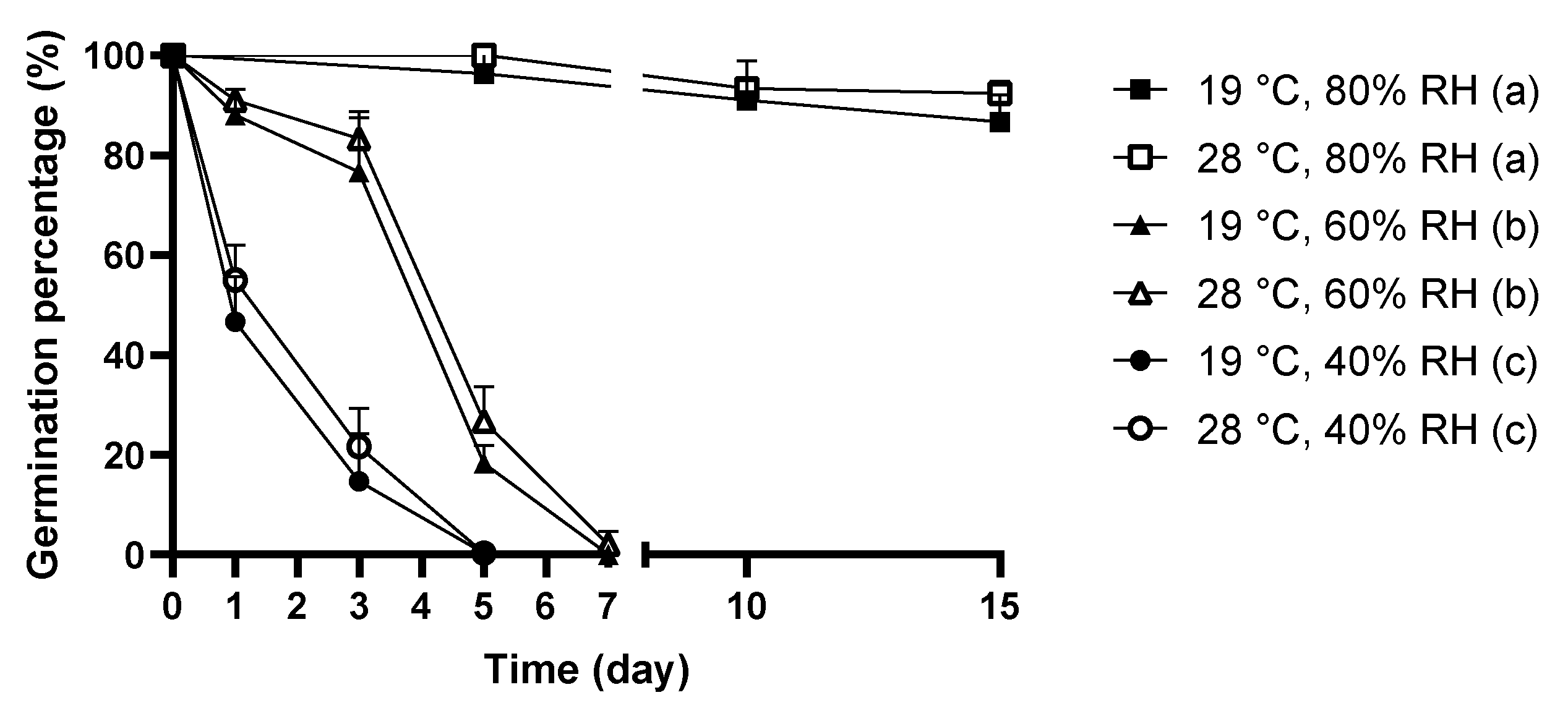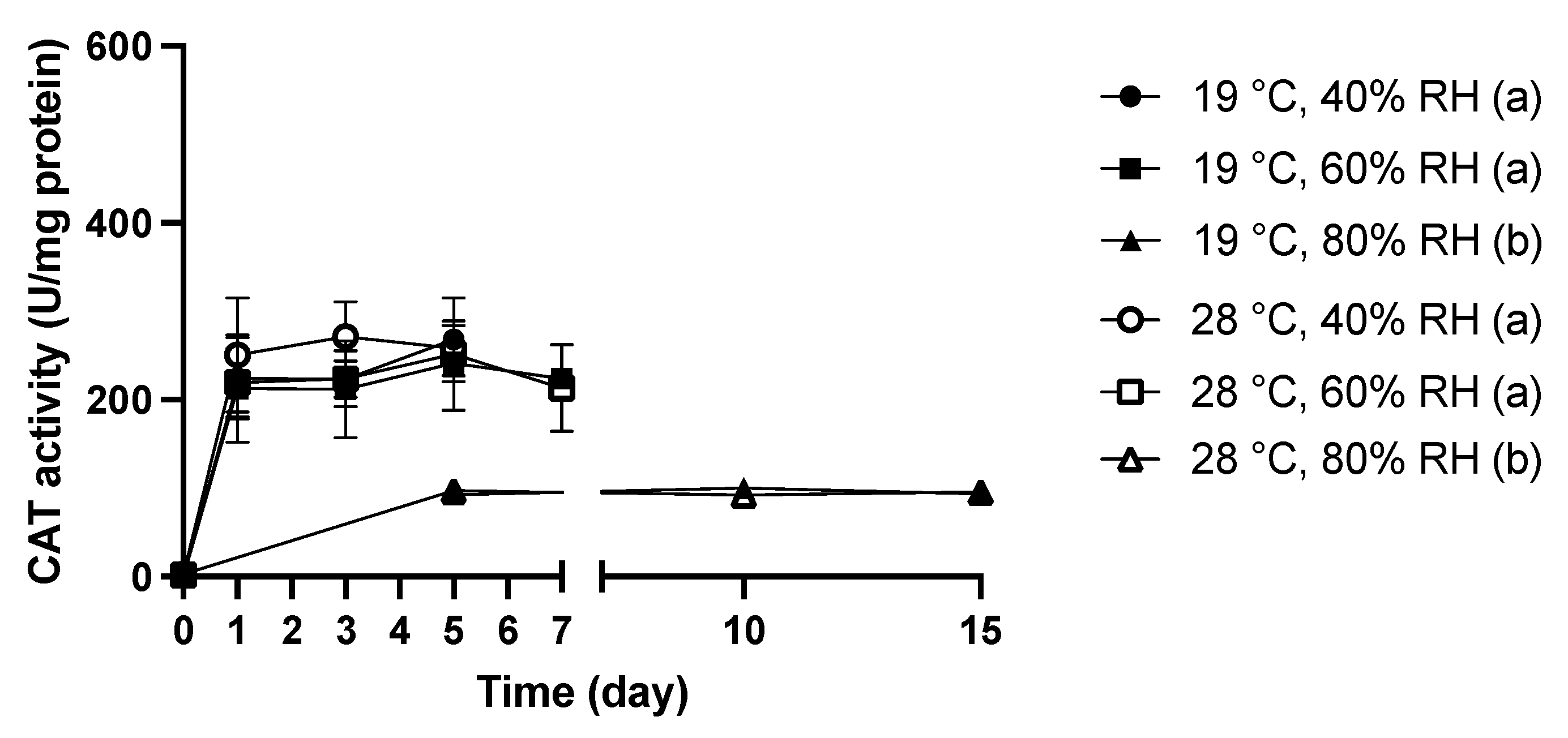Temperature versus Relative Humidity: Which Is More Important for Indoor Mold Prevention?
Abstract
:1. Introduction
2. Materials and Methods
2.1. Tested Organisms and Growth Conditions
2.2. Mold Survival under Moisture Dynamics
2.3. Quantification of Oxidative Stress
2.4. Characterisation of Antioxidant Responses
2.5. Statistical Analyses
3. Results
3.1. Viability of C. cladosporioides under Moisture Dynamics
3.2. Oxidative Stress Encountered in C. cladosporioides under Moisture Dynamics
3.3. CAT Activity of C. cladosporioides under Moisture Dynamics
4. Discussion
4.1. Insignificantly Different Resistance to Wet-Dry Cycles between 19 °C and 28 °C
4.2. Relative Humidity of Dry Periods Is More Critical Than Temperature for Mold Prevention in Indoor Environments
4.3. Similar CAT Activity Determined at 19 and 28 °C May Explain the Insignificant Effect of Temperature under Moisture Dynamics
4.4. Implications of the Study
5. Conclusions
Author Contributions
Funding
Data Availability Statement
Conflicts of Interest
References
- Tuomo, O.; Hannu, V.; Ruut, P.; Kimmo, L.; Juha, V.; Kati, S. Mold Growth Modeling of Building Structures Using Sensitivity Classes of Materials. In Proceedings of the Thermal Performance of the Exterior Envelopes of Whole Buildings XI International Conference, Clearwater Beach, FL, USA, 4–8 December 2016. [Google Scholar]
- Wu, H.; Wong, J.W.C. Current Challenges for Shaping the Sustainable and Mold-Free Hygienic Indoor Environment in Humid Regions. Lett. Appl. Microbiol. 2020, 70, 396–406. [Google Scholar] [CrossRef] [PubMed]
- Holmquist, G.U.; Walker, H.W.; Stahr, H.M. Influence of temperature, PH, water activity and antifungal agents on growth of Aspergillus flavus and A. Parasiticus. J. Food Sci. 1983, 48, 778–782. [Google Scholar] [CrossRef]
- Klaus, S. Prediction of Mold Fungus Formation on the Surface of/and inside Building Components; Fraunhofer Institute for Building Physics: Stuttgart, Germany, 2001. [Google Scholar]
- Erdogan, A.; Sert, S. Mycotoxin-Forming Ability of Two Penicillium Roqueforti Strains in Blue Moldy Tulum Cheese Ripened at Various Temperatures. J. Food Prot. 2004, 67, 533–535. [Google Scholar] [CrossRef] [PubMed]
- Johansson, P.; Bok, G.; Ekstrand-Tobin, A. The Effect of Cyclic Moisture and Temperature on Mold Growth on Wood Compared to Steady State Conditions. Build. Environ. 2013, 65, 178–184. [Google Scholar] [CrossRef]
- Micheluz, A.; Manente, S.; Tigini, V.; Prigione, V.; Pinzari, F.; Ravagnan, G.; Varese, G.C. The Extreme Environment of a Library: Xerophilic Fungi Inhabiting Indoor Niches. Int. Biodeterior. Biodegrad. 2015, 99, 1–7. [Google Scholar] [CrossRef] [Green Version]
- Wu, H.; Ng, T.W.; Wong, J.W.C.; Lai, K.M. Environmental Sustainability and Mold Hygiene in Buildings. Int. J. Environ. Res. Public Health 2018, 15, 681. [Google Scholar] [CrossRef] [Green Version]
- Bensch, K.; Braun, U.; Groenewald, J.Z.; Crous, P.W. The Genus Cladosporium. Stud. Mycol. 2012, 72, 1–401. [Google Scholar] [CrossRef] [Green Version]
- Wu, H.; Wong, J.W.C. The Role of Oxidative Stress in the Growth of the Indoor Mold Cladosporium Cladosporioides under Water Dynamics. Indoor Air 2020, 30, 117–125. [Google Scholar] [CrossRef] [PubMed]
- Wu, H.; Wong, J.W.C. Mechanisms of Indoor Mold Survival Under Moisture Dynamics, A Special Water Treatment Approach within the Indoor Context. Chemosphere 2022, 302, 134748. [Google Scholar] [CrossRef] [PubMed]
- Segers, F.J.J.; van Laarhoven, K.A.; Huinink, H.P.; Adan, O.C.G.; Wösten, H.A.B.; Dijksterhuis, J. The Indoor Fungus Cladosporium Halotolerans Survives Humidity Dynamics Markedly Better than Aspergillus Niger and Penicillium Rubens despite Less Growth at Lowered Steady-State Water Activity. Appl. Environ. Microbiol. 2016, 82, 5089–5098. [Google Scholar] [CrossRef] [PubMed] [Green Version]
- Quintana-Obregón, E.A.; Plascencia-Jatomea, M.; López-Cervantes, J.; Cira-Chávez, L.A.; Sánchez-Machado, D.I.; Cortez-Rocha, M.O. Antifungal Activity of Chitosan in Cladosporium Cladosporioides Isolated from Safflower. Rev. Mex. Micol. 2011, 34, 89–92. [Google Scholar]
- Aihara, M.; Tanaka, T.; Ohta, T.; Takatori, K. Effect of Temperature and Water Activity on the Growth of Cladosporium Sphaerospermum and Cladosporium Cladosporioides. Biocontrol Sci. 2002, 7, 193–196. [Google Scholar] [CrossRef] [Green Version]
- Briceño, E.X.; Latorre, B.A. Characterization of Cladosporium Rot in Grapevines, a Problem of Growing Importance in Chile. Plant. Dis. 2008, 92, 1635–1642. [Google Scholar] [CrossRef] [Green Version]
- Krus, M.; Kilian, R.; Sedlbauer, K. Mold Growth Prediction by Computational Simulation on Historic Buildings. In Museum Microclimates; National Museum of Denmark: Copenhagen, Denmark, 2007. [Google Scholar]
- Wyatt, T.T.; Leeuwen, M.R.; Golovina, E.A.; Hoekstra, F.A.; Kuenstner, E.J.; Palumbo, E.A.; Snyder, N.L.; Visagie, C.; Verkennis, A.; Hallsworth, J.E.; et al. Functionality and Prevalence of Trehalose-based Oligosaccharides as Novel Compatible Solutes in Ascospores of Neosartorya Fischeri (Aspergillus Fischeri) and Other Fungi. Environ. Microbiol. 2015, 17, 395–411. [Google Scholar] [CrossRef] [PubMed] [Green Version]
- Tang, J.W. The Effect of Environmental Parameters on the Survival of Airborne Infectious Agents. J. R. Soc. Interface 2009, 6, S737–S746. [Google Scholar] [CrossRef] [PubMed] [Green Version]



Publisher’s Note: MDPI stays neutral with regard to jurisdictional claims in published maps and institutional affiliations. |
© 2022 by the authors. Licensee MDPI, Basel, Switzerland. This article is an open access article distributed under the terms and conditions of the Creative Commons Attribution (CC BY) license (https://creativecommons.org/licenses/by/4.0/).
Share and Cite
Wu, H.; Wong, J.W.C. Temperature versus Relative Humidity: Which Is More Important for Indoor Mold Prevention? J. Fungi 2022, 8, 696. https://doi.org/10.3390/jof8070696
Wu H, Wong JWC. Temperature versus Relative Humidity: Which Is More Important for Indoor Mold Prevention? Journal of Fungi. 2022; 8(7):696. https://doi.org/10.3390/jof8070696
Chicago/Turabian StyleWu, Haoxiang, and Jonathan Woon Chung Wong. 2022. "Temperature versus Relative Humidity: Which Is More Important for Indoor Mold Prevention?" Journal of Fungi 8, no. 7: 696. https://doi.org/10.3390/jof8070696
APA StyleWu, H., & Wong, J. W. C. (2022). Temperature versus Relative Humidity: Which Is More Important for Indoor Mold Prevention? Journal of Fungi, 8(7), 696. https://doi.org/10.3390/jof8070696





